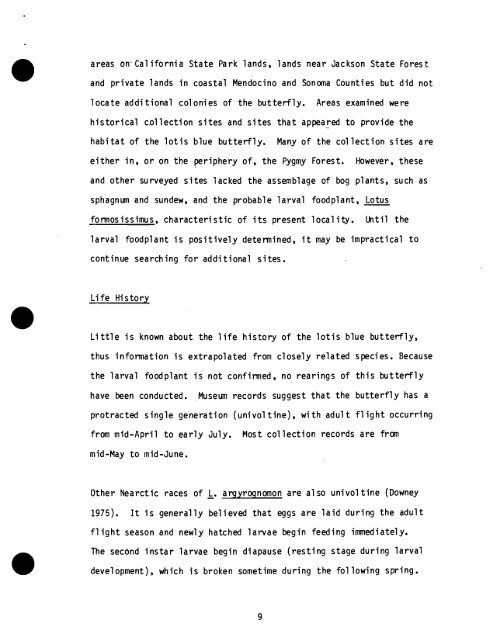Lotis Blue Butterfly Recovery Plan - U.S. Fish and Wildlife Service
Lotis Blue Butterfly Recovery Plan - U.S. Fish and Wildlife Service
Lotis Blue Butterfly Recovery Plan - U.S. Fish and Wildlife Service
Create successful ePaper yourself
Turn your PDF publications into a flip-book with our unique Google optimized e-Paper software.
areas on- Cal ifornia State Park l<strong>and</strong>s, l<strong>and</strong>s near Jackson State Forest<br />
<strong>and</strong> private l<strong>and</strong>s in coastal Mendocino <strong>and</strong> Sonoma Counties but did not<br />
1 oca t e addi tional col oni es of the butterfly. Areas examined were<br />
historical c,ollection sites <strong>and</strong> sites that appeared to provide the<br />
habitat of the lotis blue butterfly. Many of the col lection sites are<br />
either in, or on the periphery of, the Pygmy Forest. However, these<br />
<strong>and</strong> other surveyed sites lacked the assemblage of bog plants, such as<br />
sphagnum <strong>and</strong> sundew, <strong>and</strong> the probable larval foodplant, Lotus<br />
formosissimus, characteristic of its present local i ty. Until the<br />
larval foodplant is positively determined, it may be impractical to<br />
continue searching for additional sites.<br />
Life History<br />
Little is known about the 1 ife history of the lotis blue butterfly,<br />
thus information is extrapolated from closely related species. Because<br />
the larval foodplant is not confirmed, no rearings of this butterfly<br />
have been conducted. Museum records suggest that the butterfly has a<br />
protracted single generation (univol tine), with adult flight occurring<br />
from mid-April to early July. Most collection records are frm<br />
mid-May to mid-June.<br />
Other Nearctic races of - L. argyrognomon are also univol tine (Downey<br />
1975). It is generally believed that eggs are laid during the adult<br />
flight season <strong>and</strong> newly hatched larvae begin feeding immediately.<br />
The second instar larvae begin diapause (resting stage during larval<br />
development) , which is broken sometime duriqg the fol lowing spring.

















